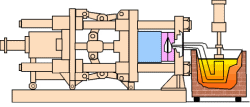What is Zinc Die Casting? Die Casting is a method wherein the molten metal is pressed down in high pressure into the mold cavities. It can be done in two ways, the hot chamber process and the cold chamber process. Die castings are mostly made out of non-ferrous metals like tin-based alloys, lead, magnesium, aluminum and copper. But the most popular non-ferrous metal used is zinc.
Because it is very easy to cast and the fact that zinc has numerous functional and decorative applications, no other methods or materials in die casting will match the economics and properties of Zinc Die Casting. Zinc alloys are more durable compared to strengthened molded polymers. The zinc is appropriate for working mechanical parts like pinions and gears because of its high modulus, dimensional stability, hardness and self-lubricating properties.
Zinc Die Casting has many advantages over other manufacturing procedures.
-
1. Compared to plastic molding, zinc die cast creates tougher parts through closer endurance to have better stability, plus it can withstand extreme temperatures.
2. Compared to sand castings, zinc die casts create parts with smoother surfaces, thinner walls and closer dimensional limits. The production is also faster with zinc die cast.
3. Compared to screw machine products, zinc die cast needs lesser operations and decrease scrap and waste. It can also produce figures that are hard to make like tubular stock and bar, while sustaining tolerances with no tooling changes.
From automotive and limitless electronic components to office equipment, tools and window hardware as well as doors and bathroom fixtures, there’s no doubt that Zinc Die Casting has definitely made a great impact in our lives.
Die Casting Zinc Blog gives information on how to get a zinc die casting part for manufacturers. If you are looking for an American Die Casting Company or if you need die casting tooling, look at Die Casting Molds will give you more information you can use for manufacturing.


